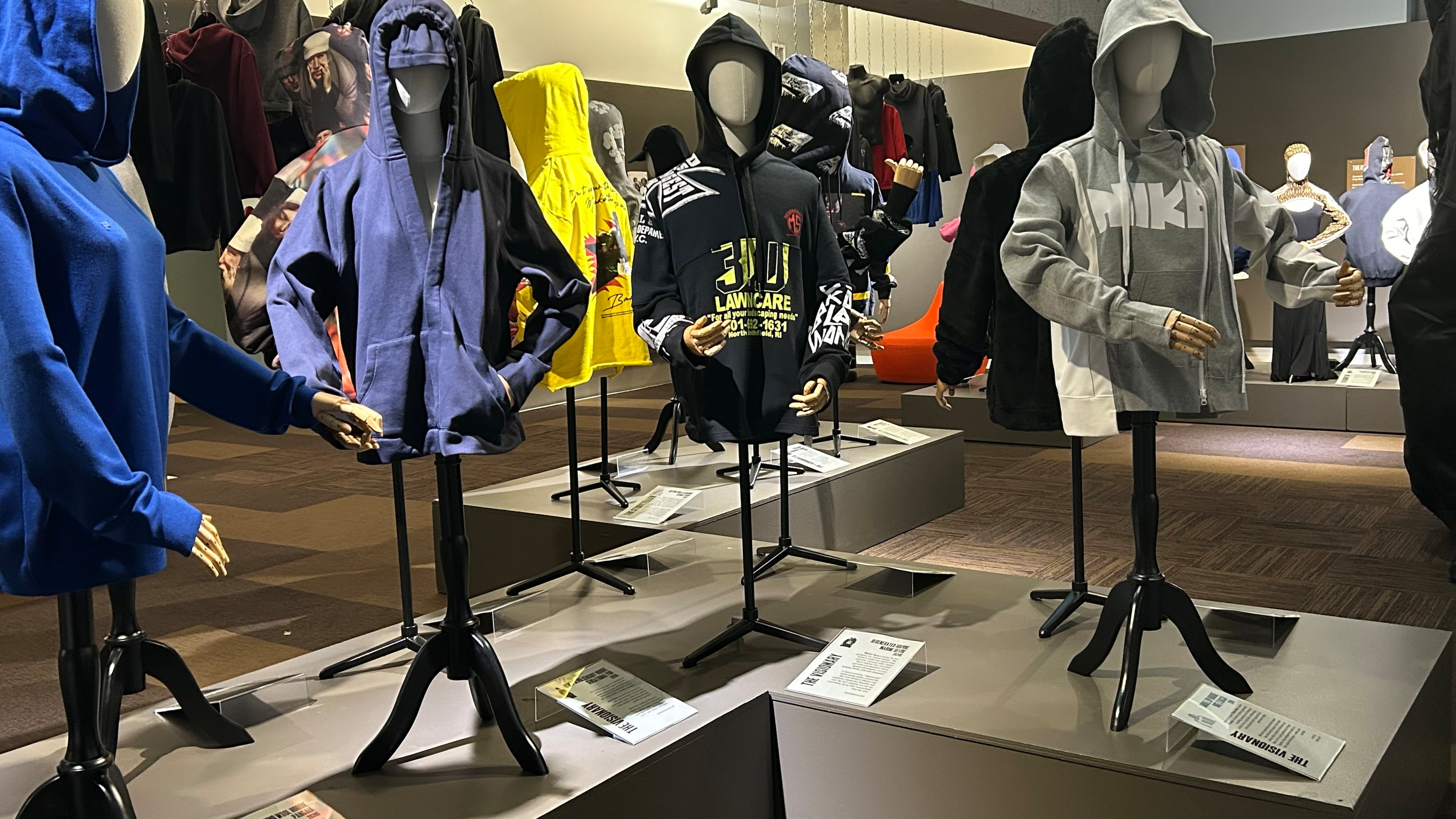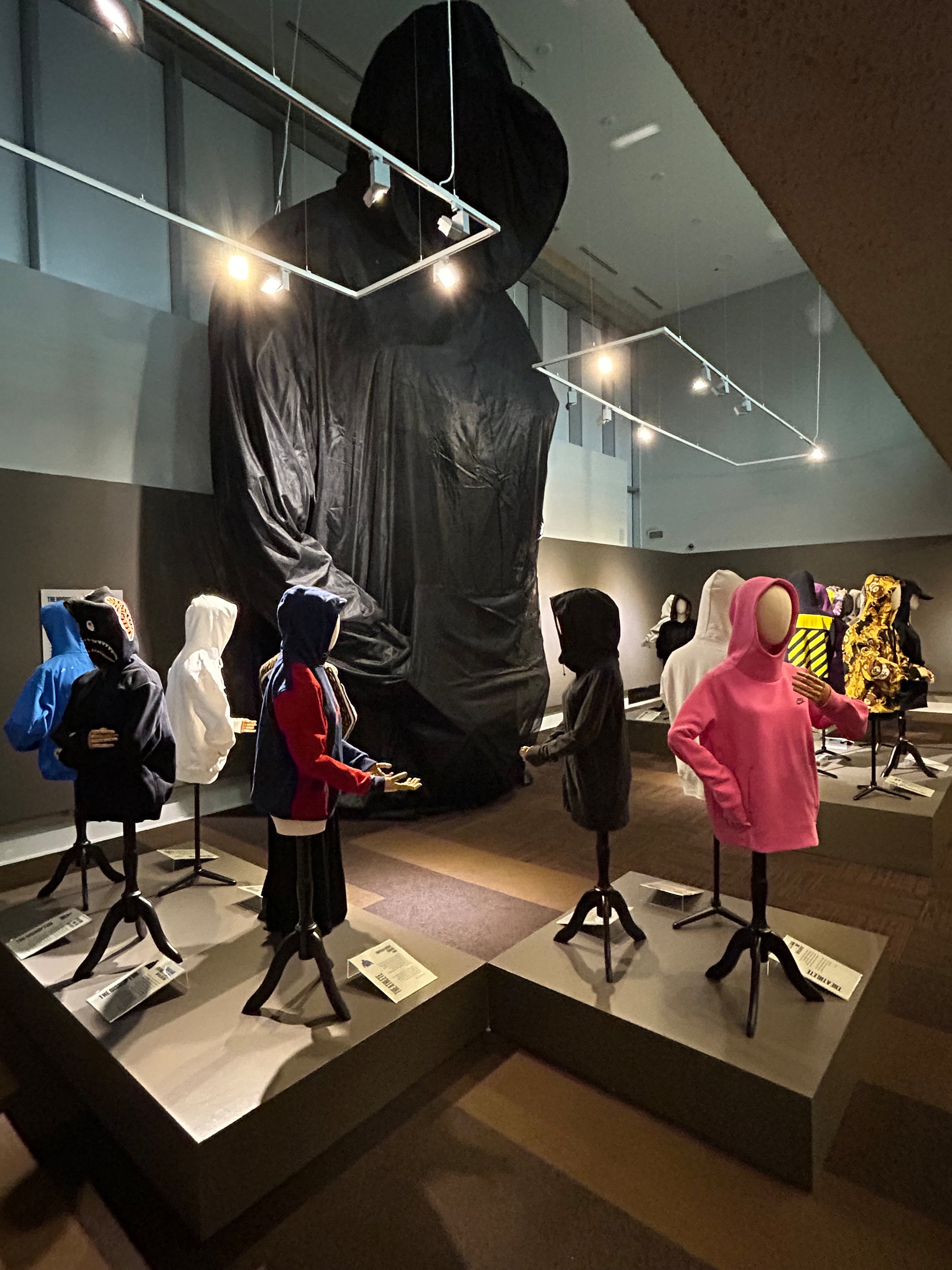MODA’s ‘Hoodie’ exhibit explores power, identity, fear of fashion garment

Strolling through Museum of Design Atlanta, wearing a pink and green hoodie embroidered with the Greek letters of Alpha Kappa Alpha sorority, Regina Bradley took stock of her work related to the gallery’s latest exhibition.
“They brought me on because my area of research interest and expertise is Southern hip-hop,” Bradley said of her role working with Laura Flusche, MODA’s executive director, as co-curator of "The Hoodie: Identity, Power, Protest," which opened to the public at noon Thursday, and will be on display at MODA through February.
Bradley is an associate professor of English and African Diaspora Studies at Kennesaw State University, and author of the book “Chronicling Stankonia: the Rise of the Hip-Hop South.” She said while doing research on the project she sought to answer a few questions surrounding the head-covering sweater, which some credit sports apparel company Champion with inventing in the 1930s.
“Why is the hoodie so dope? Why is it such a significant piece of fashion that most folks wear on a daily basis, but don’t think about the deeper meanings and understandings of what that is,” she wondered during an interview with UATL.
“It means different things to different people. It’s been politicized, especially post-Trayvon-Martin in 2012. It is a hip-hop statement, and Atlanta is a hip-hop city. And also, you know, everyday comfort.”

Inside the exhibit is a diverse array of the soft, cozy tops. They include hoodies produced by a long list of fashion brands and designers, including A Bathing Ape (BAPE), Nike and Lululemon, as well as André 3000 and Beyoncé’s Ivy Park collaboration with Adidas.
Hoodies with images ranging from Super Mario Bros. to rock band Nirvana, are hung together on a hallway collage. Others, in a separate gallery area, are draped over mannequins near a 26-foot-tall sculpture of a hoodie-wearing figure towering over the room.

Some, such as the Kriss Kross-inspired gray and white hoodie with the lyrics “Wiggida Wiggida Wiggida Wack” printed on front in white capital letters, are displayed like fine art next to descriptions explaining their significance. In this case, the hoodie represents the likelihood that the young superstar rap duo, whose 1992 single “Jump” and debut album “Totally Krossed Out” turned Jermaine Dupri into a music industry mogul, were the first hip-hop act from Atlanta to wear the garment in a video.
Bradley said they wanted to show the video for “Jump” next to the hoodie but had challenges getting permission.
“There’s a lot of stuff we didn’t get to put into the exhibit, like how sustained the hoodie has been, especially in Black culture,” she said.
“It’s been utilized, like, over and over. You start with Kriss Kross in 1992, then before that, it was Wu-Tang Clan. Before that, it was Michael Jackson and ‘Bad.’ So just being able to research the way that it evolved to reflect the cultural moment, in addition to the political landscape we live in, was really, really dope.”
Originally curated by British writer Lou Stoppard, “The Hoodie” was first presented in Rotterdam in 2019 at the Nieuwe Instituut, which gave MODA its blessing to re-curate the show to reflect how it has influenced — and been influenced by — Atlanta and the South.
Tours of the exhibit will detail the hoodie’s role as a symbol of cultural resistance and protest, as well as how it has shown in subcultures like skateboarding and hip-hop. Visitors will also see hoodies representing Atlanta’s unique streetwear scene, donated by prominent cultural figures in Atlanta like artist Chilly-O, and brands like Eastside Golf and Atlanta Influences Everything.

Guests will also be invited to take printed templates of hoodies and create their own designs that express personal beliefs, which will be displayed on a wall inside the gallery.
There are also reminders that hoodies are not exclusive to Black culture. The famous sketch of “Unabomber” Ted Kaczynski is considered, along with examples of how hoodies appear in popular culture beyond Atlanta, such as Spiderman’s Peter Parker and actor Regina King’s character Angela Abar from the HBO series “Watchmen.”

Curtis Reynolds, a member of the Atlanta-based funk band Brick (which has one of its branded hoodies included in the exhibit), attended a private preview event for “The Hoodie.” The 74-year-old Michigander called himself a fan of hoodies but said he didn’t have a favorite in the exhibit.
“It’s hard to say what was better. If you come here and respect the room, how can you not say this wall is any more elegant than a wall across the way,” Reynolds asked.
“But naturally I’m going to like the one with us (Brick) on it,” he admitted.
Co-curator Bradley said events and activations are being planned for “The Hoodie.” In the meantime she told UATL she appreciates seeing her first-ever museum curation project to fruition and is proud of not just how it all looks but what the exhibit says.
“The reason MODA is so amazing is that it opens up space to have conversations about everyday things you don’t necessarily think as deeply about,” she said.
“Taking an everyday garment and centering it into a conversation about identity, protests, resistance and resilience is something I hope that folks will continue to do.”
IF YOU GO
The Hoodie: Identity, Power, Protest
12 p.m. -7 p.m., Wed. through Sun. MODA, 1315 Peachtree Street NE, Atlanta. 404-979-6455. museumofdesign.org
